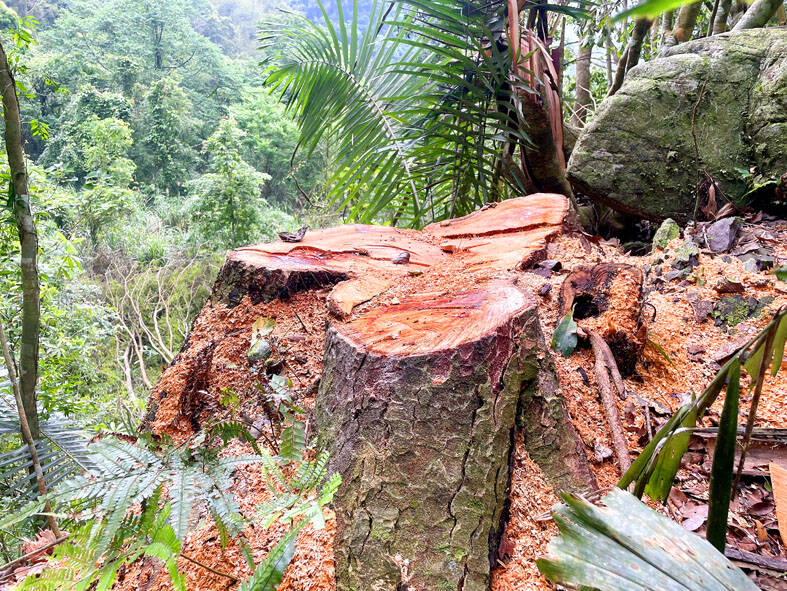The Forestry and Nature Conservation Agency on Tuesday unveiled a Web site to combat illegal logging, encouraging the public to take part in forest protection.
Data from the agency showed that reported illegal logging incidents decreased to 58 cases last year from 290 in 2013.
The agency amended the Forestry Act (森林法) in 2015 and 2021, increasing penalties for illegal logging, agency Director-General Lin Hwa-ching (林華慶) told a news conference.

Photo courtesy of the police
Although illegal logging statistics had been classified, the agency opened it to the public in 2017, in hopes that transparency would promote citizen participation in forest protection, he said.
It has mobilized student volunteers, private hiking clubs and local residents to help prevent illegal logging, with up to 91 mountain communities participating in forest patrols as of last year, Lin said.
Over the past eight years, the agency has shifted its focus from clamping down on illegal logging to preventing such activities, he said.
Illegal logging might seem like a judicial and criminal issue, but it is essentially connected with social and economic problems, Lin said, adding that many illegal loggers — especially frontline workers hired to carry and haul timber — are economically disadvantaged people.
Therefore, illegal logging should be prevented at the source by assisting local residents in establishing stable income through proper usage of forest resources, he said.
Lin also called on people not to buy burl art, as most of it is made from illegally obtained burls.
National Taipei University conservation biology associate professor Chen Shiang-fan (陳湘繁) said that her research team visited 11 prisons nationwide to interview 92 people convicted of illegal logging and analyzed thousands of verdicts.
The research showed that the median linear distance between the loggers’ residence and the illegal logging site was 20km, meaning that many illegal loggers live in areas characterized by the distribution of the tree species they logged, she said.
Where they lived were chosely related to their illegal logging activities, Chen said, adding that nearly one-third of the interviewed prisoners were indigenous people.
The situation was exacerbated by underdeveloped economies in remote areas, dysfunctional families, school dropout problems and substance abuse, she said.
The government must help develop forest economies, and promote transparency of illegal logging information and education to prevent people living in forest areas from engaging in illegal logging, Chen said.
Chuan Chih-hsiang (全志祥), an indigenous representative, said that when he returned to his village in Nantou County’s Danda Bunun (丹大布農) region, he found that illegal logging was common, as poverty drove many people to live on the money earned from it.
The situation improved as the agency began to offer afforestation and forest ranger job opportunities to young indigenous people and helped establish indigenous cooperatives to increase local income, he said, adding that illegal logging declined every year.

HORROR STORIES: One victim recounted not realizing they had been stabbed and seeing people bleeding, while another recalled breaking down in tears after fleeing A man on Friday died after he tried to fight the knife-wielding suspect who went on a stabbing spree near two of Taipei’s busiest metro stations, Taipei Mayor Chiang Wan-an (蔣萬安) said. The 57-year-old man, identified by his family name, Yu (余), encountered the suspect at Exit M7 of Taipei Main Station and immediately tried to stop him, but was fatally wounded and later died, Chiang said, calling the incident “heartbreaking.” Yu’s family would receive at least NT$5 million (US$158,584) in compensation through the Taipei Rapid Transit Corp’s (TRTC) insurance coverage, he said after convening an emergency security response meeting yesterday morning. National

Taiwan has overtaken South Korea this year in per capita income for the first time in 23 years, IMF data showed. Per capita income is a nation’s GDP divided by the total population, used to compare average wealth levels across countries. Taiwan also beat Japan this year on per capita income, after surpassing it for the first time last year, US magazine Newsweek reported yesterday. Across Asia, Taiwan ranked fourth for per capita income at US$37,827 this year due to sustained economic growth, the report said. In the top three spots were Singapore, Macau and Hong Kong, it said. South

PLANNED: The suspect visited the crime scene before the killings, seeking information on how to access the roof, and had extensively researched a 2014 stabbing incident The suspect in a stabbing attack that killed three people and injured 11 in Taipei on Friday had planned the assault and set fires at other locations earlier in the day, law enforcement officials said yesterday. National Police Agency (NPA) Director-General Chang Jung-hsin (張榮興) said the suspect, a 27-year-old man named Chang Wen (張文), began the attacks at 3:40pm, first setting off smoke bombs on a road, damaging cars and motorbikes. Earlier, Chang Wen set fire to a rental room where he was staying on Gongyuan Road in Zhongzheng District (中正), Chang Jung-hsin said. The suspect later threw smoke grenades near two exits

The Forestry and Nature Conservation Agency yesterday launched a gift box to market honey “certified by a Formosan black bear” in appreciation of a beekeeper’s amicable interaction with a honey-thieving bear. Beekeeper Chih Ming-chen (池明鎮) in January inspected his bee farm in Hualien County’s Jhuosi Township (卓溪) and found that more than 20 beehives had been destroyed and many hives were eaten, with bear droppings and paw prints near the destroyed hives, the agency said. Chih returned to the farm to move the remaining beehives away that evening when he encountered a Formosan black bear only 20m away, the agency said. The bear